Final Project: NUR-315 Pathophysiology Lupus Case Study
VerifiedAdded on 2022/12/12
|14
|3376
|237
Report
AI Summary
This report presents a comprehensive case study analysis of Lupus, focusing on the case of Flannery O'Connor, a writer diagnosed with the disease. The report begins with an introduction to Lupus, its physiological stressors, and mechanisms, including the immune system's attack on the body. It then delves into the patient's history, planning for care, interventions, and evaluation. The report covers various aspects of Lupus, including its impact on different body systems, causes, symptoms, and diagnostic challenges. It also explores treatment options, including medications and patient care technologies like telemedicine. The nursing process is applied throughout the report, with a focus on short-term and long-term goals, nursing concerns, priorities, and interventions such as patient education, pain management, and the use of health communication technologies. The report concludes with a discussion of how to improve health promotion about Lupus in communities.

Running Head: LUPUS-ISSUES
0
Lupus
student
6/24/2019
0
Lupus
student
6/24/2019
Paraphrase This Document
Need a fresh take? Get an instant paraphrase of this document with our AI Paraphraser
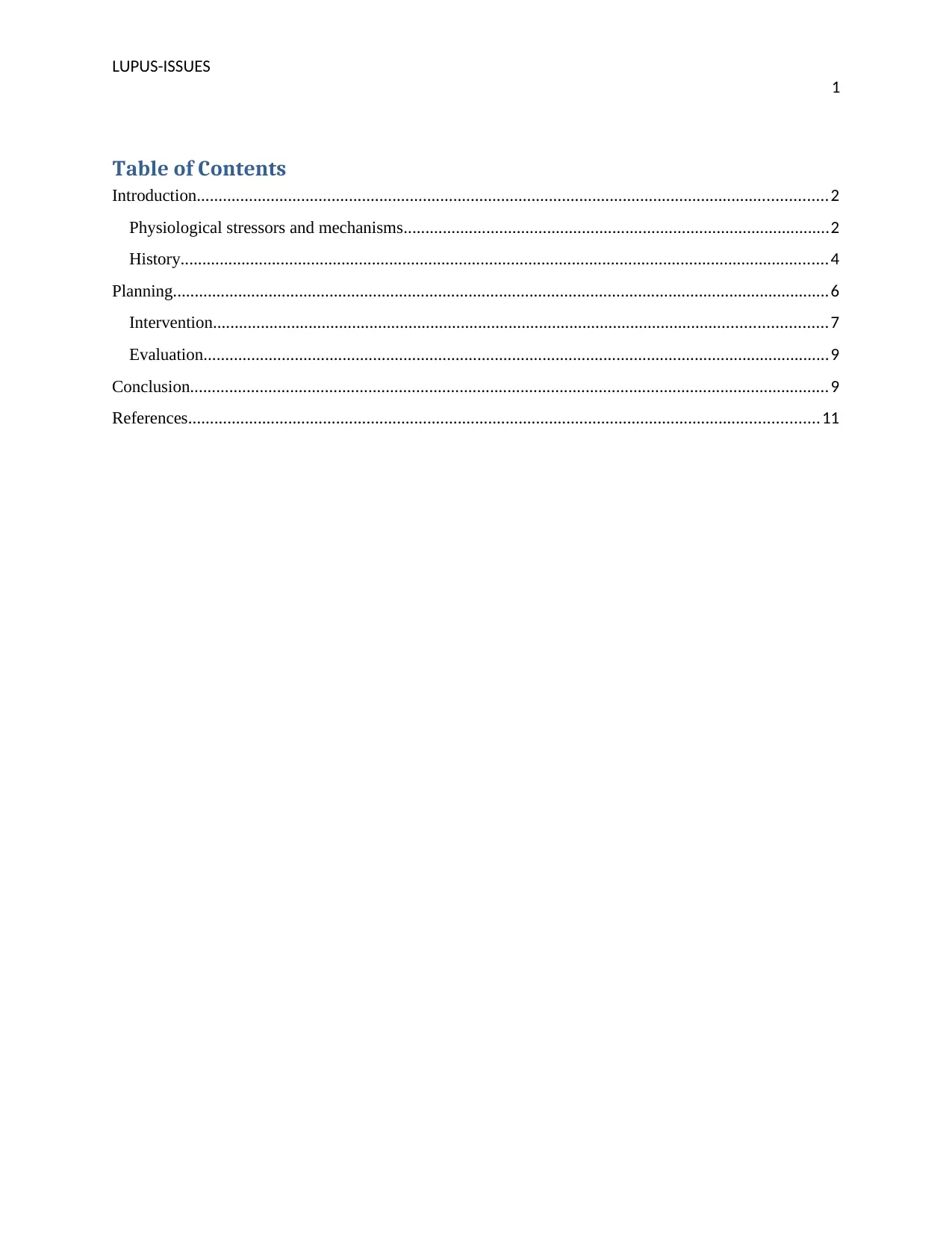
LUPUS-ISSUES
1
Table of Contents
Introduction.................................................................................................................................................2
Physiological stressors and mechanisms..................................................................................................2
History.....................................................................................................................................................4
Planning.......................................................................................................................................................6
Intervention.............................................................................................................................................7
Evaluation................................................................................................................................................9
Conclusion...................................................................................................................................................9
References.................................................................................................................................................11
1
Table of Contents
Introduction.................................................................................................................................................2
Physiological stressors and mechanisms..................................................................................................2
History.....................................................................................................................................................4
Planning.......................................................................................................................................................6
Intervention.............................................................................................................................................7
Evaluation................................................................................................................................................9
Conclusion...................................................................................................................................................9
References.................................................................................................................................................11
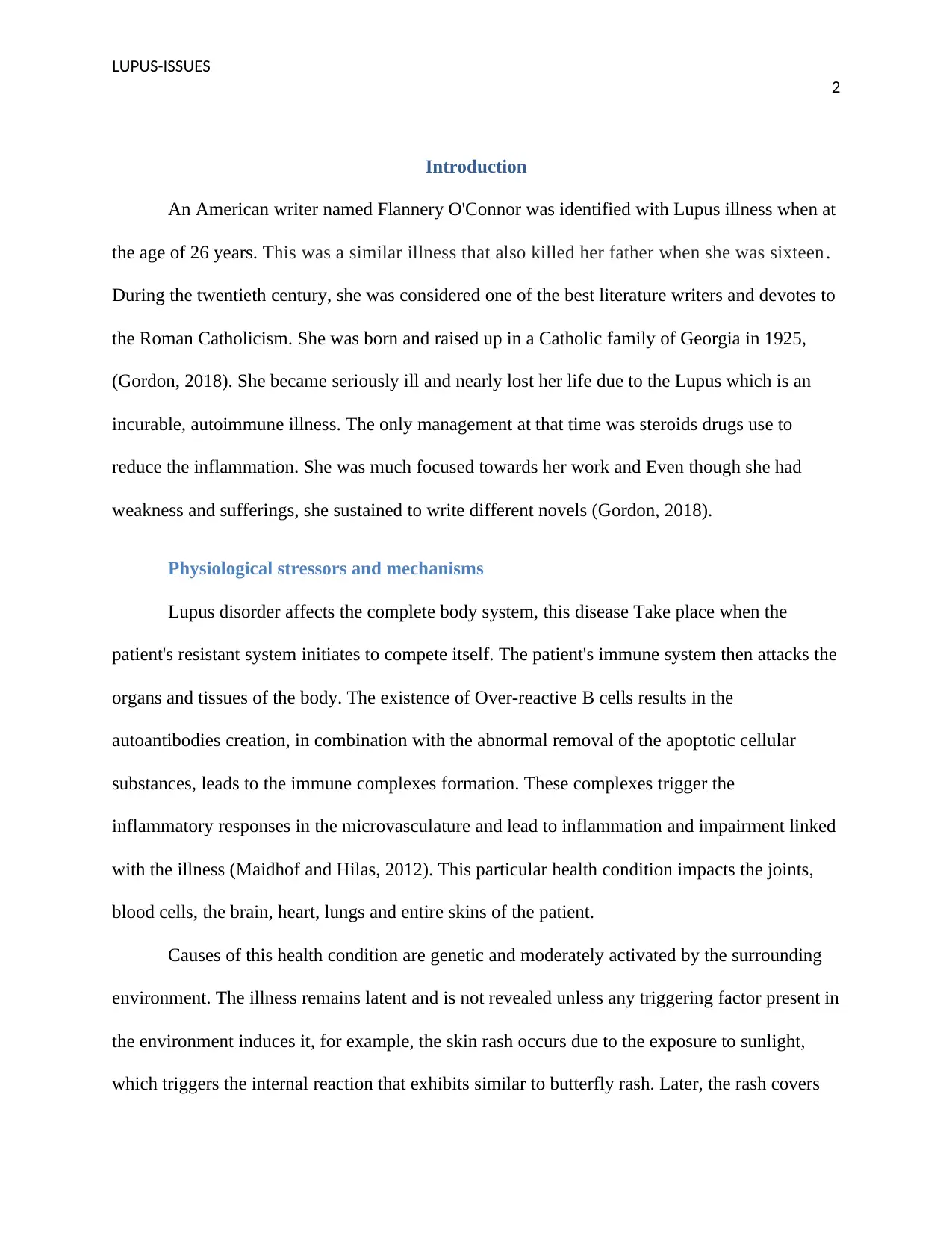
LUPUS-ISSUES
2
Introduction
An American writer named Flannery O'Connor was identified with Lupus illness when at
the age of 26 years. This was a similar illness that also killed her father when she was sixteen.
During the twentieth century, she was considered one of the best literature writers and devotes to
the Roman Catholicism. She was born and raised up in a Catholic family of Georgia in 1925,
(Gordon, 2018). She became seriously ill and nearly lost her life due to the Lupus which is an
incurable, autoimmune illness. The only management at that time was steroids drugs use to
reduce the inflammation. She was much focused towards her work and Even though she had
weakness and sufferings, she sustained to write different novels (Gordon, 2018).
Physiological stressors and mechanisms
Lupus disorder affects the complete body system, this disease Take place when the
patient's resistant system initiates to compete itself. The patient's immune system then attacks the
organs and tissues of the body. The existence of Over-reactive B cells results in the
autoantibodies creation, in combination with the abnormal removal of the apoptotic cellular
substances, leads to the immune complexes formation. These complexes trigger the
inflammatory responses in the microvasculature and lead to inflammation and impairment linked
with the illness (Maidhof and Hilas, 2012). This particular health condition impacts the joints,
blood cells, the brain, heart, lungs and entire skins of the patient.
Causes of this health condition are genetic and moderately activated by the surrounding
environment. The illness remains latent and is not revealed unless any triggering factor present in
the environment induces it, for example, the skin rash occurs due to the exposure to sunlight,
which triggers the internal reaction that exhibits similar to butterfly rash. Later, the rash covers
2
Introduction
An American writer named Flannery O'Connor was identified with Lupus illness when at
the age of 26 years. This was a similar illness that also killed her father when she was sixteen.
During the twentieth century, she was considered one of the best literature writers and devotes to
the Roman Catholicism. She was born and raised up in a Catholic family of Georgia in 1925,
(Gordon, 2018). She became seriously ill and nearly lost her life due to the Lupus which is an
incurable, autoimmune illness. The only management at that time was steroids drugs use to
reduce the inflammation. She was much focused towards her work and Even though she had
weakness and sufferings, she sustained to write different novels (Gordon, 2018).
Physiological stressors and mechanisms
Lupus disorder affects the complete body system, this disease Take place when the
patient's resistant system initiates to compete itself. The patient's immune system then attacks the
organs and tissues of the body. The existence of Over-reactive B cells results in the
autoantibodies creation, in combination with the abnormal removal of the apoptotic cellular
substances, leads to the immune complexes formation. These complexes trigger the
inflammatory responses in the microvasculature and lead to inflammation and impairment linked
with the illness (Maidhof and Hilas, 2012). This particular health condition impacts the joints,
blood cells, the brain, heart, lungs and entire skins of the patient.
Causes of this health condition are genetic and moderately activated by the surrounding
environment. The illness remains latent and is not revealed unless any triggering factor present in
the environment induces it, for example, the skin rash occurs due to the exposure to sunlight,
which triggers the internal reaction that exhibits similar to butterfly rash. Later, the rash covers
⊘ This is a preview!⊘
Do you want full access?
Subscribe today to unlock all pages.

Trusted by 1+ million students worldwide
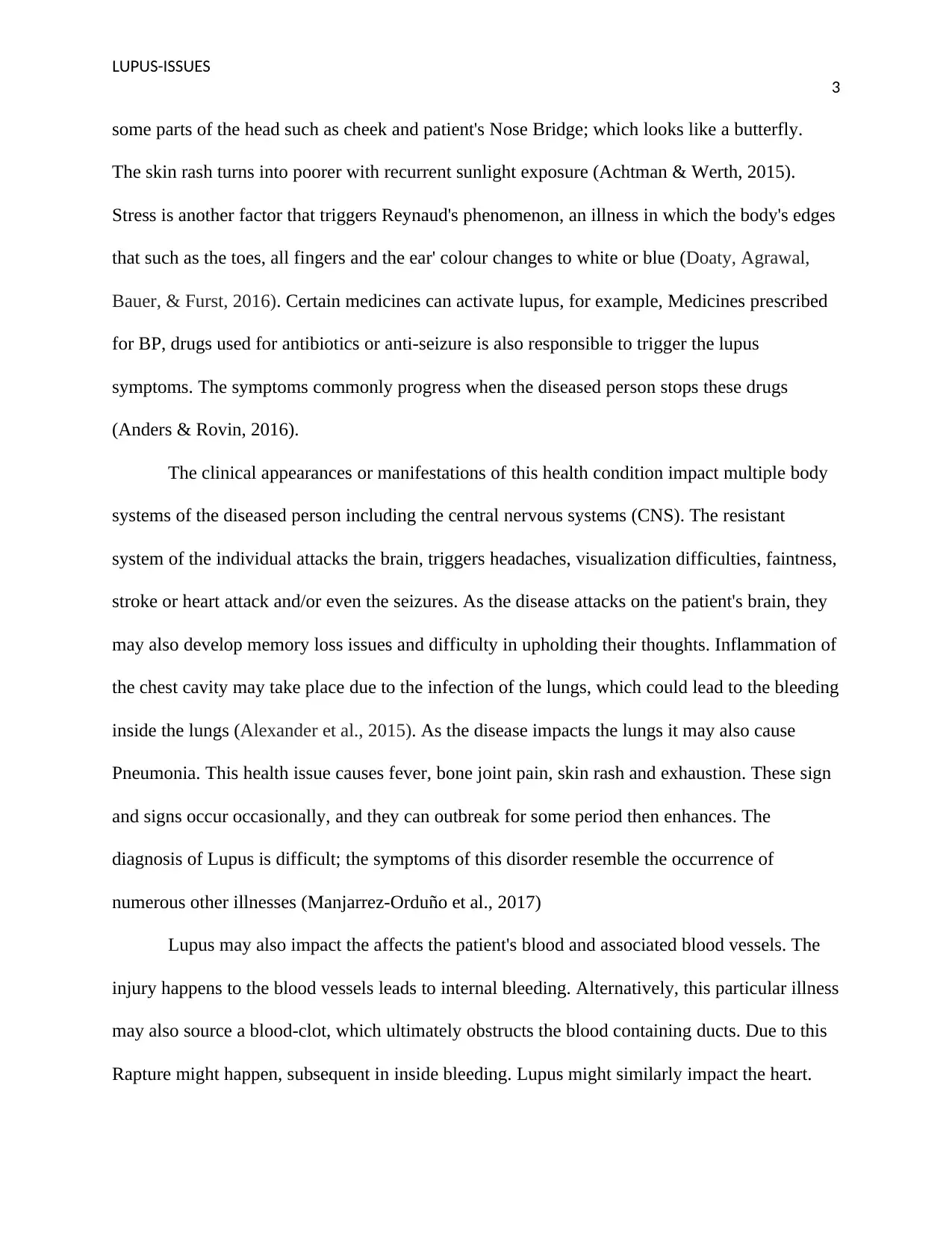
LUPUS-ISSUES
3
some parts of the head such as cheek and patient's Nose Bridge; which looks like a butterfly.
The skin rash turns into poorer with recurrent sunlight exposure (Achtman & Werth, 2015).
Stress is another factor that triggers Reynaud's phenomenon, an illness in which the body's edges
that such as the toes, all fingers and the ear' colour changes to white or blue (Doaty, Agrawal,
Bauer, & Furst, 2016). Certain medicines can activate lupus, for example, Medicines prescribed
for BP, drugs used for antibiotics or anti-seizure is also responsible to trigger the lupus
symptoms. The symptoms commonly progress when the diseased person stops these drugs
(Anders & Rovin, 2016).
The clinical appearances or manifestations of this health condition impact multiple body
systems of the diseased person including the central nervous systems (CNS). The resistant
system of the individual attacks the brain, triggers headaches, visualization difficulties, faintness,
stroke or heart attack and/or even the seizures. As the disease attacks on the patient's brain, they
may also develop memory loss issues and difficulty in upholding their thoughts. Inflammation of
the chest cavity may take place due to the infection of the lungs, which could lead to the bleeding
inside the lungs (Alexander et al., 2015). As the disease impacts the lungs it may also cause
Pneumonia. This health issue causes fever, bone joint pain, skin rash and exhaustion. These sign
and signs occur occasionally, and they can outbreak for some period then enhances. The
diagnosis of Lupus is difficult; the symptoms of this disorder resemble the occurrence of
numerous other illnesses (Manjarrez-Orduño et al., 2017)
Lupus may also impact the affects the patient's blood and associated blood vessels. The
injury happens to the blood vessels leads to internal bleeding. Alternatively, this particular illness
may also source a blood-clot, which ultimately obstructs the blood containing ducts. Due to this
Rapture might happen, subsequent in inside bleeding. Lupus might similarly impact the heart.
3
some parts of the head such as cheek and patient's Nose Bridge; which looks like a butterfly.
The skin rash turns into poorer with recurrent sunlight exposure (Achtman & Werth, 2015).
Stress is another factor that triggers Reynaud's phenomenon, an illness in which the body's edges
that such as the toes, all fingers and the ear' colour changes to white or blue (Doaty, Agrawal,
Bauer, & Furst, 2016). Certain medicines can activate lupus, for example, Medicines prescribed
for BP, drugs used for antibiotics or anti-seizure is also responsible to trigger the lupus
symptoms. The symptoms commonly progress when the diseased person stops these drugs
(Anders & Rovin, 2016).
The clinical appearances or manifestations of this health condition impact multiple body
systems of the diseased person including the central nervous systems (CNS). The resistant
system of the individual attacks the brain, triggers headaches, visualization difficulties, faintness,
stroke or heart attack and/or even the seizures. As the disease attacks on the patient's brain, they
may also develop memory loss issues and difficulty in upholding their thoughts. Inflammation of
the chest cavity may take place due to the infection of the lungs, which could lead to the bleeding
inside the lungs (Alexander et al., 2015). As the disease impacts the lungs it may also cause
Pneumonia. This health issue causes fever, bone joint pain, skin rash and exhaustion. These sign
and signs occur occasionally, and they can outbreak for some period then enhances. The
diagnosis of Lupus is difficult; the symptoms of this disorder resemble the occurrence of
numerous other illnesses (Manjarrez-Orduño et al., 2017)
Lupus may also impact the affects the patient's blood and associated blood vessels. The
injury happens to the blood vessels leads to internal bleeding. Alternatively, this particular illness
may also source a blood-clot, which ultimately obstructs the blood containing ducts. Due to this
Rapture might happen, subsequent in inside bleeding. Lupus might similarly impact the heart.
Paraphrase This Document
Need a fresh take? Get an instant paraphrase of this document with our AI Paraphraser
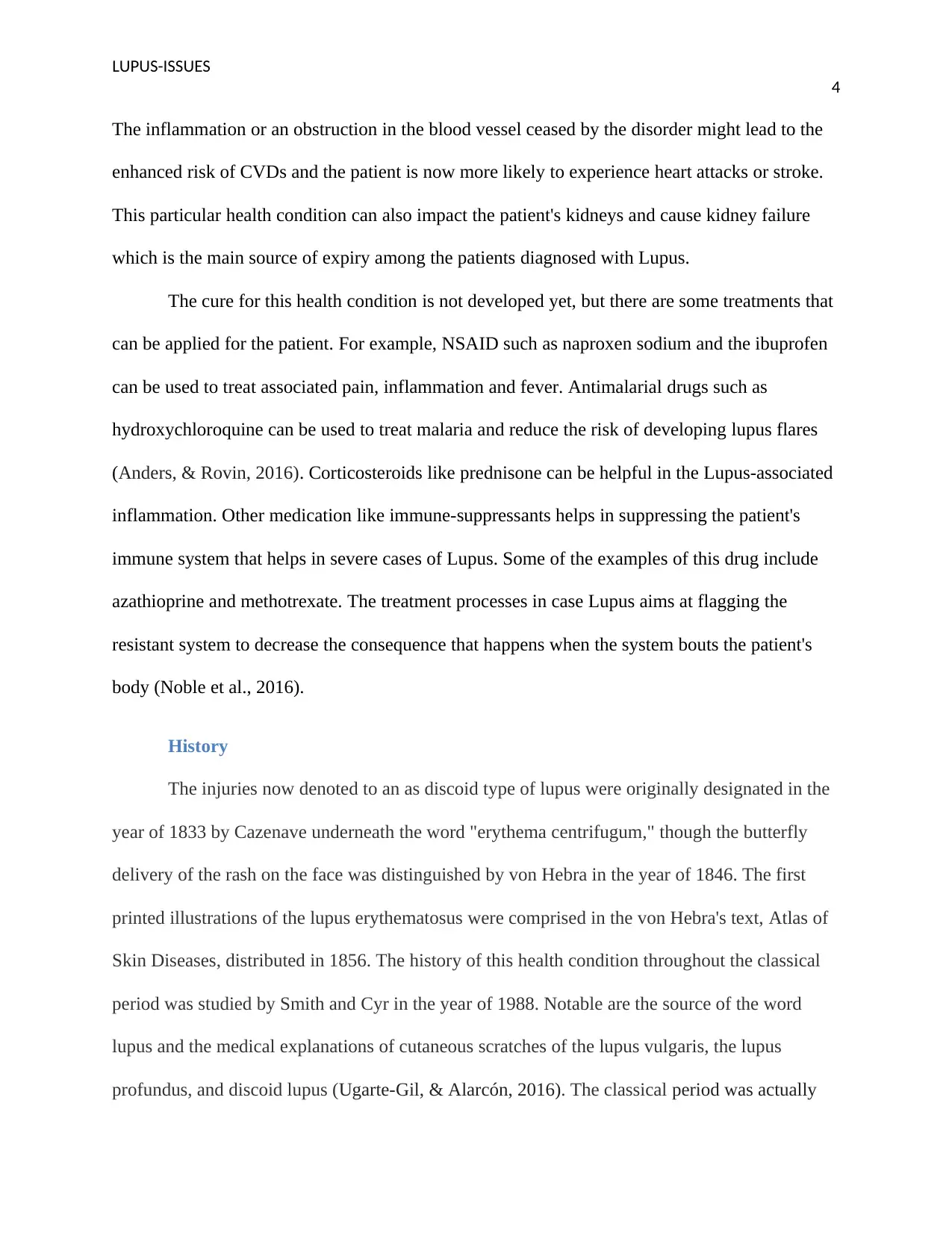
LUPUS-ISSUES
4
The inflammation or an obstruction in the blood vessel ceased by the disorder might lead to the
enhanced risk of CVDs and the patient is now more likely to experience heart attacks or stroke.
This particular health condition can also impact the patient's kidneys and cause kidney failure
which is the main source of expiry among the patients diagnosed with Lupus.
The cure for this health condition is not developed yet, but there are some treatments that
can be applied for the patient. For example, NSAID such as naproxen sodium and the ibuprofen
can be used to treat associated pain, inflammation and fever. Antimalarial drugs such as
hydroxychloroquine can be used to treat malaria and reduce the risk of developing lupus flares
(Anders, & Rovin, 2016). Corticosteroids like prednisone can be helpful in the Lupus-associated
inflammation. Other medication like immune-suppressants helps in suppressing the patient's
immune system that helps in severe cases of Lupus. Some of the examples of this drug include
azathioprine and methotrexate. The treatment processes in case Lupus aims at flagging the
resistant system to decrease the consequence that happens when the system bouts the patient's
body (Noble et al., 2016).
History
The injuries now denoted to an as discoid type of lupus were originally designated in the
year of 1833 by Cazenave underneath the word "erythema centrifugum," though the butterfly
delivery of the rash on the face was distinguished by von Hebra in the year of 1846. The first
printed illustrations of the lupus erythematosus were comprised in the von Hebra's text, Atlas of
Skin Diseases, distributed in 1856. The history of this health condition throughout the classical
period was studied by Smith and Cyr in the year of 1988. Notable are the source of the word
lupus and the medical explanations of cutaneous scratches of the lupus vulgaris, the lupus
profundus, and discoid lupus (Ugarte-Gil, & Alarcón, 2016). The classical period was actually
4
The inflammation or an obstruction in the blood vessel ceased by the disorder might lead to the
enhanced risk of CVDs and the patient is now more likely to experience heart attacks or stroke.
This particular health condition can also impact the patient's kidneys and cause kidney failure
which is the main source of expiry among the patients diagnosed with Lupus.
The cure for this health condition is not developed yet, but there are some treatments that
can be applied for the patient. For example, NSAID such as naproxen sodium and the ibuprofen
can be used to treat associated pain, inflammation and fever. Antimalarial drugs such as
hydroxychloroquine can be used to treat malaria and reduce the risk of developing lupus flares
(Anders, & Rovin, 2016). Corticosteroids like prednisone can be helpful in the Lupus-associated
inflammation. Other medication like immune-suppressants helps in suppressing the patient's
immune system that helps in severe cases of Lupus. Some of the examples of this drug include
azathioprine and methotrexate. The treatment processes in case Lupus aims at flagging the
resistant system to decrease the consequence that happens when the system bouts the patient's
body (Noble et al., 2016).
History
The injuries now denoted to an as discoid type of lupus were originally designated in the
year of 1833 by Cazenave underneath the word "erythema centrifugum," though the butterfly
delivery of the rash on the face was distinguished by von Hebra in the year of 1846. The first
printed illustrations of the lupus erythematosus were comprised in the von Hebra's text, Atlas of
Skin Diseases, distributed in 1856. The history of this health condition throughout the classical
period was studied by Smith and Cyr in the year of 1988. Notable are the source of the word
lupus and the medical explanations of cutaneous scratches of the lupus vulgaris, the lupus
profundus, and discoid lupus (Ugarte-Gil, & Alarcón, 2016). The classical period was actually

LUPUS-ISSUES
5
marked by the principal explanation of the cutaneous illness; it is similar when the period
"lupus" was discovered. 13th Century doctor Rogerius identified that the facial lesions instigated
by the illness similar to the wolf bites, henceforth the term "lupus" that indicates the wolf in
Latin. The neoclassical period instigated in 1872, this period is recognized by the explanation of
the illness’s systemic or dispersed appearances, prepared by Moriz Kaposi, a learner and son-in-
law of Ferdinand von Hebra who was the Austrian skin specialist. Kaposi even had the statement
that there were two different forms of the illness. Researchers exposed these responsible cells in
the patient's bone marrow in 1948 with the acute dispersed lupus erythematosus. Payne was the
main person who started the efficiency of quinine medicine in the process of management of the
SLE (Systemic Lupus Erythematosus) in 1894 (Couture, & Silverman, 2016).
Patient care technologies
Telemedicine denotes to medical care provided from a long distance; frequently using a
smartphone to have a video call with the clinical care professional. This could comprise
interaction or even virtual hospital visits with primary care clinicians or communal health
providers. Telemedicine became a revolutionary approach for the management of Lupus and can
be an enormous advantage for patients, principally in extents where it might be puzzling to
access the health care services (Tani, Trieste, Lorenzoni, Cannizzo, Turchetti, & Mosca, 2016).
Telemedicine technology can assist with the triaging type of patients. When the diseased person
first confers their indications to the health care provider, telemedicine can assist the patient in
getting the exact medical care they require. This can become an outstanding answer to
appointments from primary care professionals. If a diseased person is having some indications of
lupus, the telemedicine technology might save the time to visit the primary care professional to
5
marked by the principal explanation of the cutaneous illness; it is similar when the period
"lupus" was discovered. 13th Century doctor Rogerius identified that the facial lesions instigated
by the illness similar to the wolf bites, henceforth the term "lupus" that indicates the wolf in
Latin. The neoclassical period instigated in 1872, this period is recognized by the explanation of
the illness’s systemic or dispersed appearances, prepared by Moriz Kaposi, a learner and son-in-
law of Ferdinand von Hebra who was the Austrian skin specialist. Kaposi even had the statement
that there were two different forms of the illness. Researchers exposed these responsible cells in
the patient's bone marrow in 1948 with the acute dispersed lupus erythematosus. Payne was the
main person who started the efficiency of quinine medicine in the process of management of the
SLE (Systemic Lupus Erythematosus) in 1894 (Couture, & Silverman, 2016).
Patient care technologies
Telemedicine denotes to medical care provided from a long distance; frequently using a
smartphone to have a video call with the clinical care professional. This could comprise
interaction or even virtual hospital visits with primary care clinicians or communal health
providers. Telemedicine became a revolutionary approach for the management of Lupus and can
be an enormous advantage for patients, principally in extents where it might be puzzling to
access the health care services (Tani, Trieste, Lorenzoni, Cannizzo, Turchetti, & Mosca, 2016).
Telemedicine technology can assist with the triaging type of patients. When the diseased person
first confers their indications to the health care provider, telemedicine can assist the patient in
getting the exact medical care they require. This can become an outstanding answer to
appointments from primary care professionals. If a diseased person is having some indications of
lupus, the telemedicine technology might save the time to visit the primary care professional to
⊘ This is a preview!⊘
Do you want full access?
Subscribe today to unlock all pages.

Trusted by 1+ million students worldwide

LUPUS-ISSUES
6
ultimately be recommended to an expert. Telehealth technology might also assist in the post-
surgery situation, meaningfully with continuation care. Particularly in minor processes that
necessitate just a lone over-night appointment, video and the phone-dependent follow-up
appointments might assist with patient-involvement. Operation and retrieval can be painful for
the patient and stressful for their families, and extra time spent in hospitals can be frustrating and
risky for individuals with lupus or another type of autoimmune illnesses since the risk of
emerging contamination is higher. Recent improvements in health info technologies (HIT) to be
used in the SLE have comprised electronic databanks and archives, computerized medical charts
for the patient observation, computerized investigative tools, computerized forecast guidelines
and, more freshly, disease-particular applications for the smartphones for doctors, health care
providers, and patients. Conventionally, HIT improvement has been made mainly to doctors and
public managers (Quinet, Davis, Wray, Hilbun, Budziakowska, & Migliore, 2017).
Planning
The patient provided with the nursing interventions and medicinal treatment can help in recusing
the risk of system attacking the body and to stabilize the hyperactive b cells. The treatment is
provided for a few months.
Short term goals
Pain assessment is one of the significant examinations a nurse must practice in case of
Lupus patient. Numerical pain scale tool is used by asking the patient to rate the pain 2
out of 10 for the upcoming 1 day (Shin et al., 2016).
6
ultimately be recommended to an expert. Telehealth technology might also assist in the post-
surgery situation, meaningfully with continuation care. Particularly in minor processes that
necessitate just a lone over-night appointment, video and the phone-dependent follow-up
appointments might assist with patient-involvement. Operation and retrieval can be painful for
the patient and stressful for their families, and extra time spent in hospitals can be frustrating and
risky for individuals with lupus or another type of autoimmune illnesses since the risk of
emerging contamination is higher. Recent improvements in health info technologies (HIT) to be
used in the SLE have comprised electronic databanks and archives, computerized medical charts
for the patient observation, computerized investigative tools, computerized forecast guidelines
and, more freshly, disease-particular applications for the smartphones for doctors, health care
providers, and patients. Conventionally, HIT improvement has been made mainly to doctors and
public managers (Quinet, Davis, Wray, Hilbun, Budziakowska, & Migliore, 2017).
Planning
The patient provided with the nursing interventions and medicinal treatment can help in recusing
the risk of system attacking the body and to stabilize the hyperactive b cells. The treatment is
provided for a few months.
Short term goals
Pain assessment is one of the significant examinations a nurse must practice in case of
Lupus patient. Numerical pain scale tool is used by asking the patient to rate the pain 2
out of 10 for the upcoming 1 day (Shin et al., 2016).
Paraphrase This Document
Need a fresh take? Get an instant paraphrase of this document with our AI Paraphraser
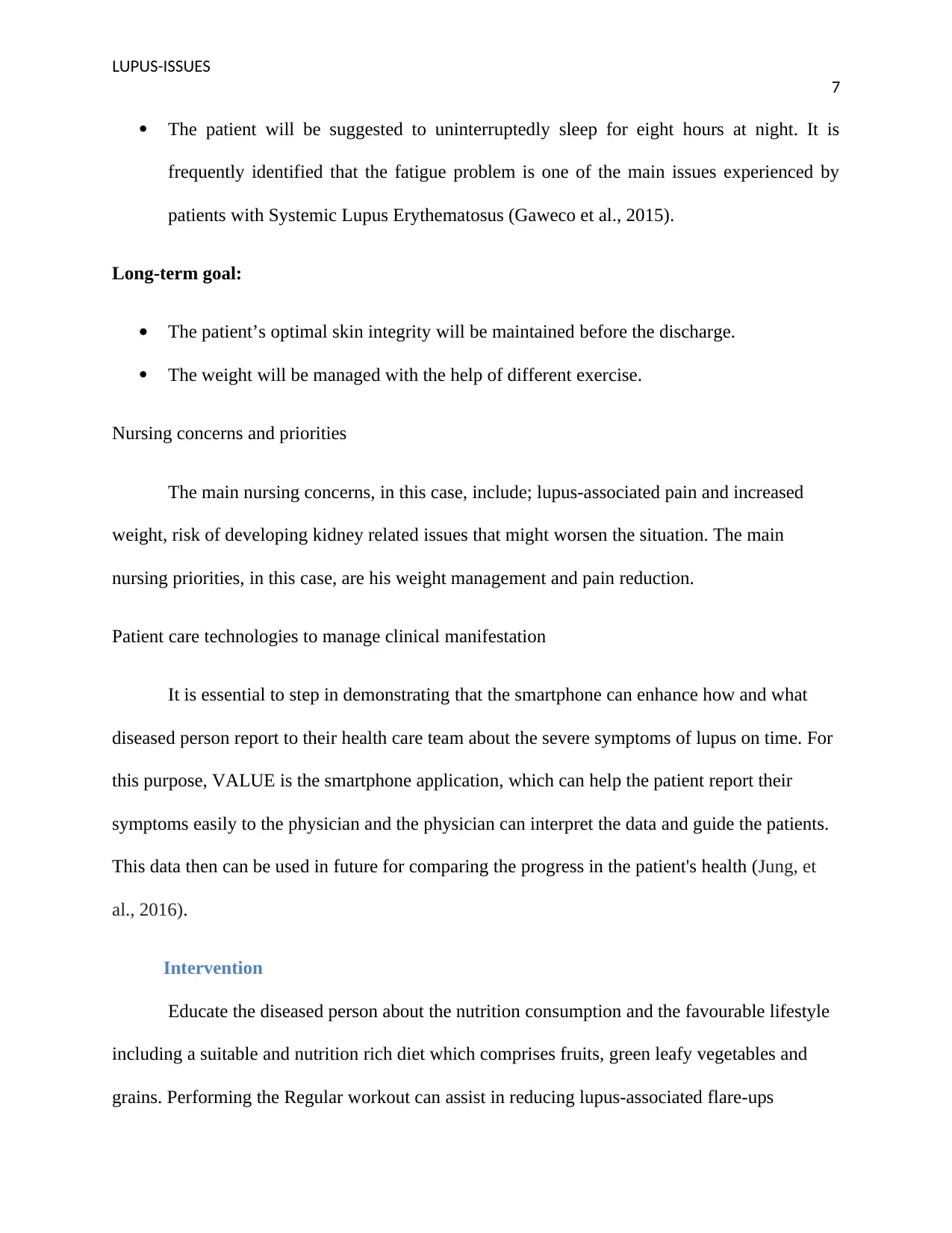
LUPUS-ISSUES
7
The patient will be suggested to uninterruptedly sleep for eight hours at night. It is
frequently identified that the fatigue problem is one of the main issues experienced by
patients with Systemic Lupus Erythematosus (Gaweco et al., 2015).
Long-term goal:
The patient’s optimal skin integrity will be maintained before the discharge.
The weight will be managed with the help of different exercise.
Nursing concerns and priorities
The main nursing concerns, in this case, include; lupus-associated pain and increased
weight, risk of developing kidney related issues that might worsen the situation. The main
nursing priorities, in this case, are his weight management and pain reduction.
Patient care technologies to manage clinical manifestation
It is essential to step in demonstrating that the smartphone can enhance how and what
diseased person report to their health care team about the severe symptoms of lupus on time. For
this purpose, VALUE is the smartphone application, which can help the patient report their
symptoms easily to the physician and the physician can interpret the data and guide the patients.
This data then can be used in future for comparing the progress in the patient's health (Jung, et
al., 2016).
Intervention
Educate the diseased person about the nutrition consumption and the favourable lifestyle
including a suitable and nutrition rich diet which comprises fruits, green leafy vegetables and
grains. Performing the Regular workout can assist in reducing lupus-associated flare-ups
7
The patient will be suggested to uninterruptedly sleep for eight hours at night. It is
frequently identified that the fatigue problem is one of the main issues experienced by
patients with Systemic Lupus Erythematosus (Gaweco et al., 2015).
Long-term goal:
The patient’s optimal skin integrity will be maintained before the discharge.
The weight will be managed with the help of different exercise.
Nursing concerns and priorities
The main nursing concerns, in this case, include; lupus-associated pain and increased
weight, risk of developing kidney related issues that might worsen the situation. The main
nursing priorities, in this case, are his weight management and pain reduction.
Patient care technologies to manage clinical manifestation
It is essential to step in demonstrating that the smartphone can enhance how and what
diseased person report to their health care team about the severe symptoms of lupus on time. For
this purpose, VALUE is the smartphone application, which can help the patient report their
symptoms easily to the physician and the physician can interpret the data and guide the patients.
This data then can be used in future for comparing the progress in the patient's health (Jung, et
al., 2016).
Intervention
Educate the diseased person about the nutrition consumption and the favourable lifestyle
including a suitable and nutrition rich diet which comprises fruits, green leafy vegetables and
grains. Performing the Regular workout can assist in reducing lupus-associated flare-ups

LUPUS-ISSUES
8
(Tunnicliffe, et al., 2018). Warm or icy compression can be applied to the agonizing areas and
joints to relieve the pain. Nurses can also Administer Analgesics as prescribed by the physician
for pain management. Range of gesture and comfort can be provided to the patient to evade
contractures (He et al., 2016). The must also be Reassessed for the pain after the 30 minutes pain
medicine administration. The peaceful environment should be maintained. For any lesion, skin
rash or pressure ulcers, the patient must be assessed daily. The patient can also apply sunscreens
or they can also cover the skin to avoid direct contact with sunlight when going outside (Ladwig
& Ackley, 2014). Some of the medicines can be used to treat the patient includes NSAIDs,
antimalarial type of drugs, different corticosteroids like prednisone, immunosuppressant’s like
Imuran, Azasan, CellCept to suppress the immune system, and biologics such as belimumab, and
rituximab (Yates, 2018).
To improve the health promotion about Lupus in communities Health Communication and
Health Information Technology can be used as a tool. The information about the disease can be
uploaded on the portal, from which the community members can gain important information.
The distributing material about the campaign for Lupus prevention can be download from the
portal easily. It can also help in developing, reviewing and reprinting the suitable material (Tani
et al., 2016).
Health care providers are generally motivated to record and inform the medication events
by one or more of numerous conventional controlled medication mistake reporting systems for
instance the MedWatch Program of Food and Drug Administration’s, MedMARx program of the
U.S. Pharmacopeial Convention, and Medication Errors Reporting Program of the Institute for
Safe Medication Practices (Ghaferi, & Dimick, 2015). The Medication Error Prioritization
System (MEPS) was intended with the partial obtainability of professional and possessions in
8
(Tunnicliffe, et al., 2018). Warm or icy compression can be applied to the agonizing areas and
joints to relieve the pain. Nurses can also Administer Analgesics as prescribed by the physician
for pain management. Range of gesture and comfort can be provided to the patient to evade
contractures (He et al., 2016). The must also be Reassessed for the pain after the 30 minutes pain
medicine administration. The peaceful environment should be maintained. For any lesion, skin
rash or pressure ulcers, the patient must be assessed daily. The patient can also apply sunscreens
or they can also cover the skin to avoid direct contact with sunlight when going outside (Ladwig
& Ackley, 2014). Some of the medicines can be used to treat the patient includes NSAIDs,
antimalarial type of drugs, different corticosteroids like prednisone, immunosuppressant’s like
Imuran, Azasan, CellCept to suppress the immune system, and biologics such as belimumab, and
rituximab (Yates, 2018).
To improve the health promotion about Lupus in communities Health Communication and
Health Information Technology can be used as a tool. The information about the disease can be
uploaded on the portal, from which the community members can gain important information.
The distributing material about the campaign for Lupus prevention can be download from the
portal easily. It can also help in developing, reviewing and reprinting the suitable material (Tani
et al., 2016).
Health care providers are generally motivated to record and inform the medication events
by one or more of numerous conventional controlled medication mistake reporting systems for
instance the MedWatch Program of Food and Drug Administration’s, MedMARx program of the
U.S. Pharmacopeial Convention, and Medication Errors Reporting Program of the Institute for
Safe Medication Practices (Ghaferi, & Dimick, 2015). The Medication Error Prioritization
System (MEPS) was intended with the partial obtainability of professional and possessions in
⊘ This is a preview!⊘
Do you want full access?
Subscribe today to unlock all pages.

Trusted by 1+ million students worldwide

LUPUS-ISSUES
9
mind and systematizes part of the medication mistake evaluation process for diabetic patients
(Quinet et al., 2017)
Evaluation
The pain has been assessed as recommend and the results were positive, the patient reported
to have low pain compared to previous days. The numerical pain scale was used to assess the
pain. Providing proper sleep to the patient helped in reducing the fatigue-related issues, it also
reduced body inflammation, stabilized mood, and increased the patient's concentration. Third,
appropriate skin care is provided successfully to evade ulcers or other complication
complications. With the help of a healthy diet and proper exercise patient's weight in reduced and
he felt energetic during the nursing assessment. In upcoming the days the patient’s weight will be
reduced to the set target. His short term goals have been achieved with the nursing interventions
and medication, although she needs more care and treatment processes to keep her safe from
other complication associated with lupus.
Conclusion
To conclude the main concerns of the assessment report it can be specified that, to evade
any harshness in the health condition of the person suffering from the SLE or Systemic lupus
erythematosus, it is essential to apply proper interventions and the healthy daily routine. The
procedure of practicing the theoretical nursing framework assists the healthcare providers to
deliver a better knowledge and treatment to the diseased person and perceive health. It can also
be concluded that the patient must use the advance health care technologies such as telemedicine
and HIT to keep herself up-to-date about her symptoms and reporting to the physicians. The
9
mind and systematizes part of the medication mistake evaluation process for diabetic patients
(Quinet et al., 2017)
Evaluation
The pain has been assessed as recommend and the results were positive, the patient reported
to have low pain compared to previous days. The numerical pain scale was used to assess the
pain. Providing proper sleep to the patient helped in reducing the fatigue-related issues, it also
reduced body inflammation, stabilized mood, and increased the patient's concentration. Third,
appropriate skin care is provided successfully to evade ulcers or other complication
complications. With the help of a healthy diet and proper exercise patient's weight in reduced and
he felt energetic during the nursing assessment. In upcoming the days the patient’s weight will be
reduced to the set target. His short term goals have been achieved with the nursing interventions
and medication, although she needs more care and treatment processes to keep her safe from
other complication associated with lupus.
Conclusion
To conclude the main concerns of the assessment report it can be specified that, to evade
any harshness in the health condition of the person suffering from the SLE or Systemic lupus
erythematosus, it is essential to apply proper interventions and the healthy daily routine. The
procedure of practicing the theoretical nursing framework assists the healthcare providers to
deliver a better knowledge and treatment to the diseased person and perceive health. It can also
be concluded that the patient must use the advance health care technologies such as telemedicine
and HIT to keep herself up-to-date about her symptoms and reporting to the physicians. The
Paraphrase This Document
Need a fresh take? Get an instant paraphrase of this document with our AI Paraphraser

LUPUS-ISSUES
10
nursing intervention found to be effective in this case includes administrating pain relive
medicines, educating the patient about proper diet and exercises.
10
nursing intervention found to be effective in this case includes administrating pain relive
medicines, educating the patient about proper diet and exercises.

LUPUS-ISSUES
11
References
Alexander, T., Sarfert, R., Klotsche, J., Kühl, A. A., Rubbert-Roth, A., Lorenz, H. M., & Taddeo,
A. (2015). The proteasome inhibitor bortezomib depletes plasma cells and ameliorates
clinical manifestations of refractory systemic lupus erythematosus. Annals of the
rheumatic diseases, 74(7), 1474-1478.
Anders, H. J., & Rovin, B. (2016). A pathophysiology-based approach to the diagnosis and
treatment of lupus nephritis. Kidney international, 90(3), 493-501.
Anders, H. J., & Rovin, B. (2016). A pathophysiology-based approach to the diagnosis and
treatment of lupus nephritis. Kidney international, 90(3), 493-501.
Couture, J., & Silverman, E. D. (2016). Update on the pathogenesis and treatment of childhood-
onset systemic lupus erythematosus. Current opinion in rheumatology, 28(5), 488-496.
del Pino‐Sedeño, T., Trujillo‐Martín, M. M., Ruiz‐Irastorza, G., Cuellar‐Pompa, L., de Pascual‐
Medina, A. M., Serrano‐Aguilar, P., & Spanish Systemic Lupus Erythematosus CPG
Development Group. (2016). Effectiveness of nonpharmacologic interventions for
decreasing fatigue in adults with systemic lupus erythematosus: a systematic
review. Arthritis care & research, 68(1), 141-148.
Doaty, S., Agrawal, H., Bauer, E., & Furst, D. E. (2016). Infection and lupus: which causes
which?. Current rheumatology reports, 18(3), 13.
Gaweco, A., Matthews, K., Palmer, S., Shamilov, R., Adam, K., Elia, A., & Ginzler, E. (2015).
OP0137 Complete Survival and Disease Amelioration in MRL/LPR Mice Following
Therapeutic Administration of an Oral Retinoic Acid Receptor-Related Orphan Receptor
11
References
Alexander, T., Sarfert, R., Klotsche, J., Kühl, A. A., Rubbert-Roth, A., Lorenz, H. M., & Taddeo,
A. (2015). The proteasome inhibitor bortezomib depletes plasma cells and ameliorates
clinical manifestations of refractory systemic lupus erythematosus. Annals of the
rheumatic diseases, 74(7), 1474-1478.
Anders, H. J., & Rovin, B. (2016). A pathophysiology-based approach to the diagnosis and
treatment of lupus nephritis. Kidney international, 90(3), 493-501.
Anders, H. J., & Rovin, B. (2016). A pathophysiology-based approach to the diagnosis and
treatment of lupus nephritis. Kidney international, 90(3), 493-501.
Couture, J., & Silverman, E. D. (2016). Update on the pathogenesis and treatment of childhood-
onset systemic lupus erythematosus. Current opinion in rheumatology, 28(5), 488-496.
del Pino‐Sedeño, T., Trujillo‐Martín, M. M., Ruiz‐Irastorza, G., Cuellar‐Pompa, L., de Pascual‐
Medina, A. M., Serrano‐Aguilar, P., & Spanish Systemic Lupus Erythematosus CPG
Development Group. (2016). Effectiveness of nonpharmacologic interventions for
decreasing fatigue in adults with systemic lupus erythematosus: a systematic
review. Arthritis care & research, 68(1), 141-148.
Doaty, S., Agrawal, H., Bauer, E., & Furst, D. E. (2016). Infection and lupus: which causes
which?. Current rheumatology reports, 18(3), 13.
Gaweco, A., Matthews, K., Palmer, S., Shamilov, R., Adam, K., Elia, A., & Ginzler, E. (2015).
OP0137 Complete Survival and Disease Amelioration in MRL/LPR Mice Following
Therapeutic Administration of an Oral Retinoic Acid Receptor-Related Orphan Receptor
⊘ This is a preview!⊘
Do you want full access?
Subscribe today to unlock all pages.

Trusted by 1+ million students worldwide
1 out of 14
Related Documents
Your All-in-One AI-Powered Toolkit for Academic Success.
+13062052269
info@desklib.com
Available 24*7 on WhatsApp / Email
![[object Object]](/_next/static/media/star-bottom.7253800d.svg)
Unlock your academic potential
Copyright © 2020–2025 A2Z Services. All Rights Reserved. Developed and managed by ZUCOL.





